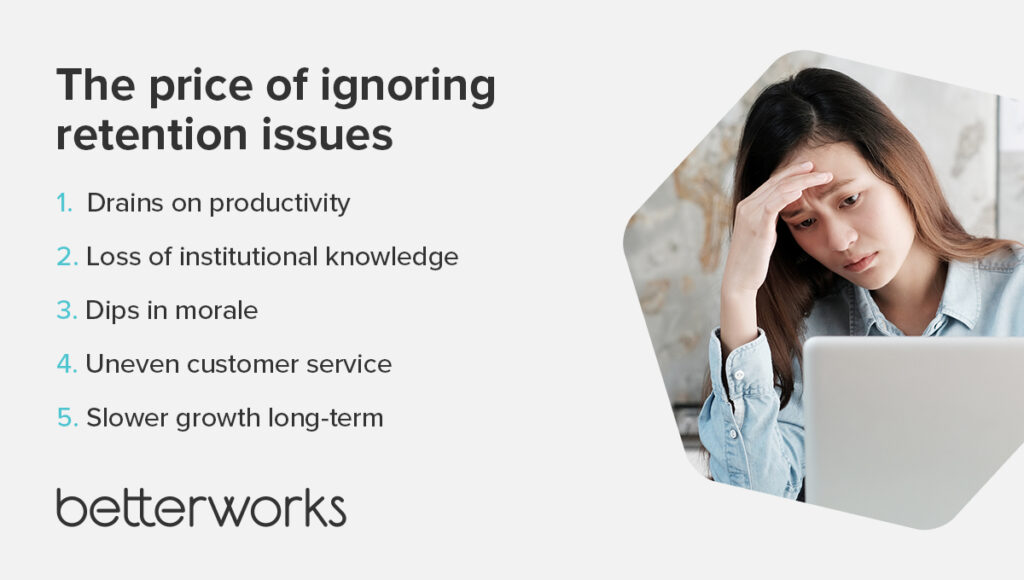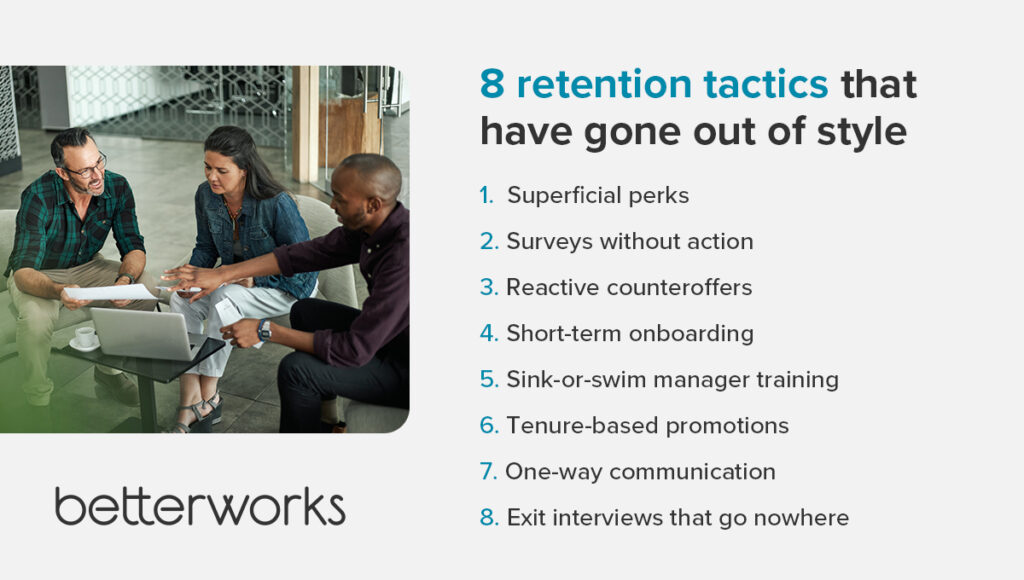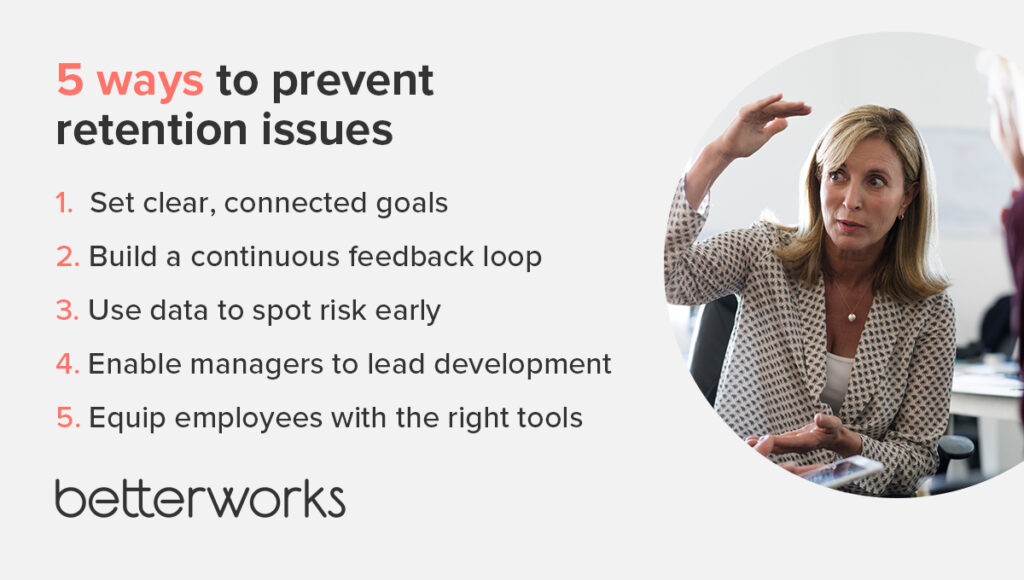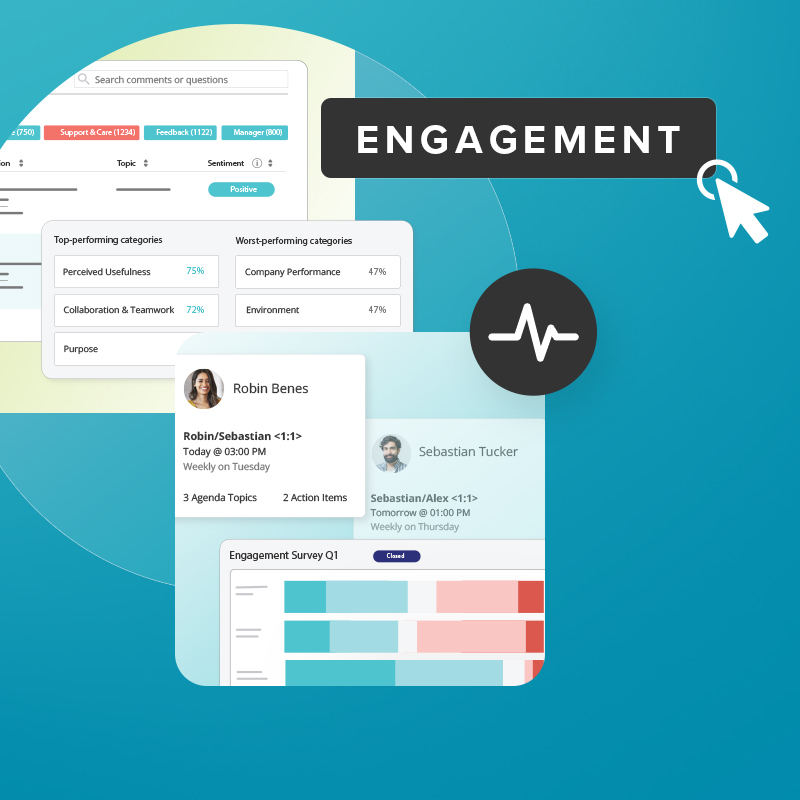Retention problems rarely start with a resignation. They begin quietly — a missed 1:1, a stalled promotion, a missed quota. By the time an exit interview lands on your calendar, it’s too late to course-correct.
The good news? Many of these issues can be avoided. The Work Institute’s 2025 Retention Report found that 75% of employee exits can be traced to preventable factors such as lack of career development, insufficient manager support, and poor work-life balance.
Retention is a leading indicator of organizational health. High retention reflects clarity of purpose, strong leadership and culture, and systems that help people succeed. When these fundamentals erode, even top performers start looking elsewhere. Perks and quick fixes can’t repair the deep structural issues that lead to low employee retention.
Solving employee retention challenges requires systemic change: aligning goals with strategy, enabling managers, and creating a performance culture where employees see a future worth staying for.
What are retention issues?
Employee retention issues — also called retention problems, retention difficulties, or retention challenges — refer to the obstacles organizations face in keeping employees engaged and committed. At their core, these issues point to systemic gaps: unclear growth paths, inconsistent feedback, poorly trained managers, and a lack of purpose-driven work.
The real challenges of employee retention today can’t be addressed through pay or perks alone. It’s about connection — between strategy and individual goals, between managers and employees, and between performance and growth. When that connection breaks, even strong performers disengage.
Common causes include:
- Misaligned goals: Employees can’t see how their work contributes to business outcomes.
- Inconsistent feedback: Guidance comes too late or not at all, leaving people uncertain about progress.
- Manager gaps: Leaders lack tools and support to coach effectively.
- Limited visibility: Employees don’t know where they stand or how to grow.
- Unclear communications: Employees receive conflicting information or are caught off guard by changing expectations that aren’t clearly articulated.
These problems rarely surface all at once. They build gradually, often going unnoticed until exit interviews or survey data confirm a decline in employee morale. That’s why leading organizations focus on employee retention strategies that create visibility, drive progress, and keep people connected to meaningful work.
5 hidden costs of ignoring retention problems
Employee retention issues and challenges add up to expensive problems in large organizations. The direct recruiting costs are easy to track, but the impact also ripples across performance, culture, and customer experience.
Drains on productivity
Replacing an employee can cost up to 200% of their salary. That’s before factoring in lost momentum, slower execution, and the time high performers spend training new hires instead of focusing on their own work.
Loss of institutional knowledge
Departing employees take context and insights with them. Rebuilding that knowledge can take months or even years, slowing execution and innovation.
Dips in morale
Turnover affects those who stay. Increased workloads, higher stress, and constant change erode trust and collaboration. Even strong cultures falter when exits become more frequent.
Uneven customer service
Experienced employees generally deliver better service and make fewer mistakes. Their departure can lead to service gaps and declining quality.
Slower growth long-term
High turnover also slows down growth and progress. Teams that bounce between cycles of hiring, onboarding, and turnover can’t focus on strategic work. Innovation slows. Momentum fades.

How Crakmedia cut its turnover rate in half
Crakmedia needed to onboard new hires faster and keep them engaged long-term to reduce costly turnover. By partnering with Betterworks, the company implemented structured goal-setting and continuous feedback, including 30-, 60-, and 90-day onboarding plans. The results: voluntary turnover dropped from 34% to 15%, engagement scores improved, and managers gained tools to lead performance effectively.
8 retention tactics that no longer work
Retention is harder today because the workplace has fundamentally changed, but it’s a crisis only for organizations that fail to adapt. These legacy tactics might feel familiar, but they no longer deliver results.
Superficial perks
Happy hours and free snacks can boost morale for a day, but they don’t create a sense of purpose or career momentum, which are the real drivers of retention.
Surveys without action
Asking for feedback without showing results does more harm than good. Employees assume leadership isn’t listening and stop sharing honest input.
Reactive counteroffers
Throwing money at an employee on their way out buys time, not loyalty. It does nothing to address why they were ready to leave in the first place.
Short-term onboarding
A great first week means little if support disappears on day 10. Without a comprehensive onboarding process, new hires can quickly lose direction and confidence.
Sink-or-swim manager training
Managers shape the employee experience, yet many are left to figure it out alone. Without enablement, performance coaching falls apart.
Tenure-based promotions
Employees no longer wait years for recognition. They expect advancement tied to contributions, not a person’s start date.
One-way communication
Top-down announcements don’t build engagement. People want dialogue and visibility into decisions that affect their work.
Exit interviews that go nowhere
Insights from departing employees are gold — if they’re used. Ignoring them guarantees you’ll repeat the same mistakes.
Outdated strategies aren’t minor gaps; they represent systemic weaknesses in how organizations connect people to purpose and growth.

How to address challenges in retaining employees
Fixing retention challenges starts with structural change, not surface-level fixes. These strategies help organizations build alignment, support managers, and create a culture where employees choose to stay and grow.
- Set clear, connected goals
When employees see how their work drives business outcomes, engagement rises. Use goal frameworks like OKRs to create alignment and purpose across the organization.
- Build a continuous feedback loop
Feedback should be part of everyday work, not a once-a-year event. Regular, actionable conversations help employees improve their performance, grow, and feel valued.
- Use data to spot risk early
Turnover rarely happens without warning. Monitor performance and engagement trends to identify early signs of disengagement and act before it’s too late.
- Enable managers to lead development
Managers are the linchpin of retention. Give them tools, training, and systems to coach effectively, recognize achievements, and guide career growth.
- Equip employees with the right tools
Retention improves when people have what they need to succeed. From performance platforms to clear processes, consistent enablement removes friction and builds trust.
These strategies aren’t quick fixes — they’re the foundation for a retention model that scales.

Stop retention issues before they take hold
Retention issues aren’t random. They result from broken systems, unclear goals, weak feedback, and a lack of visible growth. But when you fix the structure, you can change the outcome.
Learn how to fix retention issues through spotting early signs of disengagement, supporting managers with the right tools, and building a performance culture where your best people stay, grow, and thrive.
Download the ebook to learn how high-performing organizations address retention challenges at the root, stopping turnover before it starts.
Are you holding onto talented employees?





